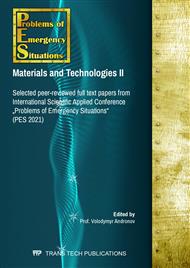[1]
V.Ya. Kofman, Serovodorod i metan v kanalizacionnyx setyax (obzor), Vodosnabzhenie i sanitarnaya texnika. 11 (2012) (in Russian).
Google Scholar
[2]
S.V. Fedorov, V.M. Vasil`ev, M.N. Klementev, Issledovanie gazovydeleniya na uchastke kanalizacionnoj seti, Vodosnabzhenie i sanitarnaya texnika. 5 (2019) (in Russian).
Google Scholar
[3]
I. Valentina, L. Elena, B. Elena, Environmental Safety of the Sewage Disposal by the Sewerage Pipelines, Transbaltica-2015. Procedia Engineering. 134 (2016) 181-186.
DOI: 10.1016/j.proeng.2016.01.058
Google Scholar
[4]
G.Ya. Drozd, N.I. Zotov, V.N. Maslak, Kanalizacionnye truboprovody: nadezhnost, diagnostika, sanaciya, Doneczk: IEP NAN, Ukrainy, 2003. (in Russian).
Google Scholar
[5]
V.A. Yurchenko, E.V. Brigada, Kineticheskie xarakteristiki mikrobiologicheskoj korrozii betona v setyax vodootvedeniya, Voda i ekologiya. Problemy i resheniya. 1 (2014) 51-61 (in Russian).
Google Scholar
[6]
G. Dmitri, G. Alexei, B. Dmitri, Z. Gennadii, On renovation of the destroyed tunnel sewer collector in Kharkov, World journal of Tngineering. 13 (2016) 72-76.
Google Scholar
[7]
N.K. Rozental, Korroziya i zashhita betonnyx i zhelezobetonnyx konstrukcij sooruzhenij ochistki stochnyx vod, Beton i zhelezobeton. Oborudovanie, materialy, texnologiya. 1 (2011) 96-103. (in Russian).
Google Scholar
[8]
L.N. Fesenko, A.Yu. Cherkesov, S.I. Ignatenko, Metody udaleniya serovodoroda iz proizvodstvenny`x stochny`x vod i puti ix razvitiya, Voda Magazine. 2 (102) (2016) https://watermagazine.ru/nauchnye-stati2/novye-stati/24763-metody-udaleniya-serovodoroda-iz-proizvodstvennykh-stochnykh-vod-i-puti-ikh-razvitiya.html. (in Russian).
Google Scholar
[9]
A.S. Vinogradova, Yu.V. Trofimenko, Metody ochistki stochnyx vod ot serovodoroda na proizvodstvennyx uchastkax avtoservisa, Nauchnoe obozrenie. Pedagogicheskie nauki. 2-3 (2019) 19-21. (in Russian).
Google Scholar
[10]
R.Z. Saxabutdinov, Rrazrabotka texnologicheskix processov sbora, podgotovki i transportirovki uglevodorodnogo syrya s minimalnymi poteryami uglevodorodov i vybrosami vrednyx veshhestv v atmosferu. diss… doktora texn. nauk: 25.00.17. Tatarskij nauchno-issledovatelskij i proektnyj institut nefti, Bugulma, 2001. (in Russian).
Google Scholar
[11]
F.A. Agzamov, L.N. Lomakina, N.B. Hababutdinova, R.F. Davletshin, A.K. Kriga, T.V. Tokunov, Cement stone corrosion processes affected by acidulous components of bedded fluids, Геология. Геофизика. Бурение. 13(4) (2015).
Google Scholar
[12]
V.M. Vasilev, G.A. Pankova, Yu.V. Stolbixin, Razrushenie kanalizacionny`x tonnelej i sooruzhenij na nix vsledstvie mikrobiologicheskoj korrozii, Vodosnabzhenie i sanitarnaya texnika. 9 (2013) 67-76. (in Russian).
Google Scholar
[13]
A.Yu. Cherkesov, Ochistka sernisto-shchelochnykh stochnykh vod nefteorgsinteza ot serovodoroda: dis. kand. tekhn. nauk [Purification of Sulfurous-Alkaline Waste Waters of Petroleum Synthesis from Hydrogen Sulfide: Cand. Engin. Sci. Diss.], , Novocherkasskii politekhnicheskii universitet Publ. Novocherkassk. 2014. [in Russian].
Google Scholar
[14]
D.G. Zvyagintsev, Methods of soil microbiology and biochemistry, Ed. Moscow, Moscow State University. Moscow, 1991. (in Russian).
Google Scholar
[15]
Unificirovanny`e metody issledovaniya kachestva vod. Metody ximicheskogo analiza vod, Moscow, 1987. 662. (in Russian).
Google Scholar
[16]
L.N. Popov, Laboratornye ispytaniya stroitelnyx materialov i izdelij, Vysshaya shkola, Moscow, 1984. (in Russian).
Google Scholar
[17]
A.A. Usyk, I.L. Derkach, E.A. Shishkin Issledovanie processa massoperenosa serovodoroda v sisteme «gaz-zhidkost», Kommunalnoe xozyajstvo gorodov. 93 (2010) 414-421. (in Russian).
Google Scholar


